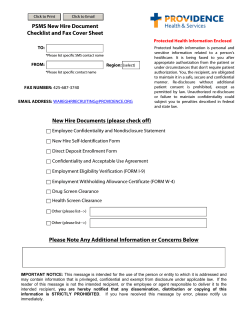
Overview Australian Government Statistical Forum
Australian Government Statistical Forum 1 November 2012 Melissa Gare Analytical Services Branch Overview • What is confidentiality and why should we care? • Framework for managing identification risk • Overview of the ABS suite of data products • Latest ABS developments in interactive user querying of detailed unit record data • Current and future research and development directions 1 Information is power • Banker in Maryland obtained a list of patients with cancer – compared with list of clients with outstanding loans – called in the loans of clients with cancer. Source: Data confidentiality: a review of methods for statistical disclosure limitation and methods for assessing privacy (Statist. Surv. Volume 5 (2011), 1-29. Confidentiality: What is it & why should you care? • It’s about obligations – legal/ethical • Aim – protect identity and release useful data • It’s more than removing name & address • Trust of providers is essential to get good stats 2 How agencies meet these obligations • Implement procedures to address all aspects of data protection • To ensure that identifiable information: – is not released publicly; – is available on a ‘need to know’ basis; – can’t be derived from disseminated data; and – is maintained and accessed securely. Managing identification risk Understand your obligations Establish policies and procedures De-identify the data Assess potential identification risks Test and evaluate to mitigate risks Manage the risks - confidentialise Provide safe access to data 3 ABS Suite of Analysis Products New environment for analysing microdata ✔ ✔ ✔ ✔ x Analysis of an expanded and more detailed range of ABS source data with outputs confidentialised rather than inputs User friendly menu driven interfaces Responsive on demand tabulation and analysis Reduced time between publication and when microdata files are available to researchers Reduced set of analytical procedures supported 4 Current External Researcher Environment MURF CURF Process CURF Analysis Output Future ABS Research Environment User selects technique Data Transforms Tabular Linear MURF Logistic Probit Confidentiality Filters Filter 1 Filter 2 Filter 3 Confidentialised Outputs Output Filter 4 Filter 5 Multinomial 5 •TableBuilder Development • Census TableBuilder – 2006 and 2011 Census of Population and Housing • Survey TableBuilder – Release 1 (population counts) • Education and Work, 2011 • Characteristics of Recent Migrants, 2010 • Disability, Ageing and Carers, 2009 • Disability, Ageing and Carers, 2003 (Basic CURF) – Late 2012 Release 2 (means, medians, quantiles and custom ranges) • 2011-13 Australian Health Survey 6 7 •Analysis Service development • Release 1 – early 2013 – Dataset manipulation – Basic tabulation – Modelling (Robust linear, Binomial and Poisson) • Release 2 – June 2013 – Enhanced Modelling (Multi-level, multinomial) Future Research Directions • Understanding disclosure risks associated with new and/or highly identifiable datasets and emerging analytical techniques • Developing confidentiality approaches to minimise disclosure risk while maintaining value of these new datasets • Demonstrating that well developed confidentiality techniques have minimal impact on analyses. Linked Administrative Longitudinal Business 8 What are AGSF member views on: – How the ABS can assist the NSS to enhance confidentiality capability and increase availability of data holdings for informed decision making? – What are the research priorities that would assist policy development? Linked Administrative Longitudinal Business 9
© Copyright 2025





















